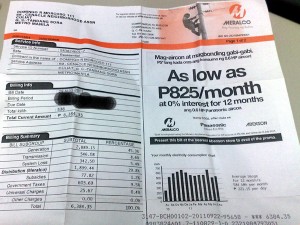MANILA, Philippines—Customers of Manila Electric Co., the country’s biggest power distributor, can expect their electricity bills to go up by 27 centavos per kilowatt-hour this month due to increases in the generation, transmission and other charges.
This means that households consuming 100 kWh in a month can expect their power bills to go up by P20.53, while those consuming 200 kWh will see an increase of P54.54, according to Lawrence S. Fernandez, assistant vice president and head of utility economics of Meralco.
Households consuming 300 kWh and 400 kWh would be charged power bill hikes of P81.80 and P109.07, respectively, Fernandez said by phone on Wednesday.
In a statement issued on Wednesday, Meralco disclosed that the generation charge for April rose by 20 centavos per kWh to P5.39 per kWh. Despite the increase, the generation charge this month remains to be 40 centavos lower than the January 2013 level of P5.79 per kWh.
Meralco explained that with the onset of summer, a 5-percent increase in the daily electricity usage was noted in March (the consumption for which would be billed in April) compared to February, thus prompting the distribution utility to more than double the volume electricity it has been getting from the wholesale electricity spot market to 2.9 percent in March from only 1.3 percent in February.
“Some power plants likewise underwent maintenance shutdown in March, necessitating the additional power obtained from WESM,” the power firm further explained.
The effective rate from WESM, which includes line rentals and must-run and other adjustments, stood at a steep P19.92 per kWh.
The cost of power taken from the independent power producers (IPPs) and Meralco’s power supply agreements (PSAs) also increased by 8 centavos and 2 centavos per kWh, respectively, due mainly to higher coal prices and a depreciation of the Philippine peso against the US dollar.
Meanwhile, the cost of power bought from state-run National Power Corp. (Napocor) rose significantly to P9.89 per kWh, after the government firm was allowed to recover costs associated with fuel and purchased power through the Generation Rate Adjustment Mechanism (GRAM) and incremental currency exchange rate adjustment (Icera) mechanism since January this year.
For the supply month of March, Meralco secured 51 percent of its electricity requirements from its power supply agreements; 39 percent from IPPs; and 10 percent from other sources including Napocor and WESM.
Other bill components likewise registered increases, according to Meralco. The transmission charge and other charges increased by 1 centavo and 6 centavos per kWh.
“Given that consumers’ electricity consumption historically rise during the summer months, Meralco likewise reminded its customers to observe energy efficiency tips. Customers may visit Meralco’s website at www.meralco.com.ph for said tips,” the power firm said.
Meralco stresses that it does not earn from generation charges. Payments for the generation charge, a pass-through cost for Meralco, go to the power suppliers such as the IPPs, participating plants in the PSAs, Napocor and WESM.
The rest of the pass-through costs included transmission, taxes, universal charges, and other charges.
Meralco’s own rates—in the form of distribution, supply and metering charges—account for only about 16 percent of the total electricity bill.


